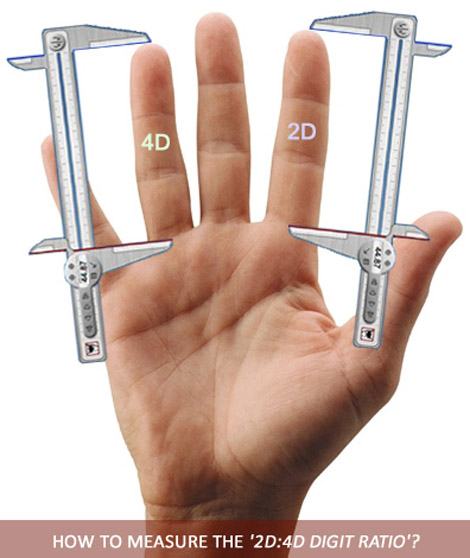

Having said that, the same year Putz et al was published, Lutchmaya et al published some findings from a study in which testosterone and estradiol were recorded from pregnant women in their second trimester of pregnancy in 19.

However, out of 57 correlations, 2D:4D correlated significantly in the predicted direction only with sexual orientation (for both sexes) and only for left hand 2D:4D. 2D:4D measures showed highly significant sex differences, as did spatial ability, sociosexuality, components of reproductive and mating success, and fluctuating asymmetry. In addition, we examined the relationship between 2D:4D measures and several other traits whose expression is thought to be related to sex hormones, including voice pitch, sociosexuality, mating success, and fluctuating asymmetry. In the present study, we reassessed the relationships among three measures of 2D:4D (left hand, right hand, and mean) and several variables previously claimed to be related to 2D:4D, including sexual orientation, spatial ability, status, physical prowess, and components of reproductive success. (yet again in Evolution and Human Behavior) wrote a paper called, “Sex hormones and finger length: What does 2D:4D indicate?”, concluding, more or less, not much. There has been a certain degree of skepticism surrounding this area for some time. It’s unlikely that the work is underpowered their power analysis indicates a greater than 90% chance of finding a significant correlation if the size of the true correlation were comparable to that found in the original paper. They also reported that testosterone levels didn’t significantly correlate with the genetic variability. (They also measured ‘bioavailable’ testosterone.)ĭespite a highly typical range and distribution of both 2D:4D ratios and CAG numbers, we found no evidence of a positive correlation between CAGn and either the right 2D:4D ratio, r=−.085, p=.327, or the left 2D:4D ratio, r=−.063, p=.468 (95% CI=−.230 to. So, they measured 2D:4D ratios of 152 men and genotyped them to look at this relationship. Hampson and Sankar suggest that there is some evidence which seems to be consistent with this finding, but also review a small number of studies that cast some doubt on it. This relationship was taken to be evidence that relative differences in androgen exposure during early development could lead to small differences in the 2D:4D ratio. (2003), who measured 2D:4D ratios and also took genetic measurements, specifically looking at repeat polymorphisms in a gene known to be involved with androgen receptors. In particular, they point to a key paper (also published in Evolution and Human Behavior) by Manning et al. Hampson and Sankar, in a paper entitled, “Re-examining the Manning hypothesis: androgen receptor polymorphism and the 2D:4D digit ratio,” point out that while hundreds of studies have been conducted on this issue, a key finding that emerged at the start of this line of work has not been replicated. A new paper, just out online (paywall) in Evolution and Human Behavior adds important new evidence to this research area. The reason is that this ratio has been believed to be a record of how much a developing fetus was exposed to androgens during development and therefore masculinized. The 2D:4D digit ratio is the ratio of the length of the second finger to the fourth finger – pointer divided by ring finder – and, it seems to me, new research comes out all the time from researchers looking at the relationship between 2D:4D and something.

The 2D:4D Ratio: A New Paper Points the Finger


 0 kommentar(er)
0 kommentar(er)
